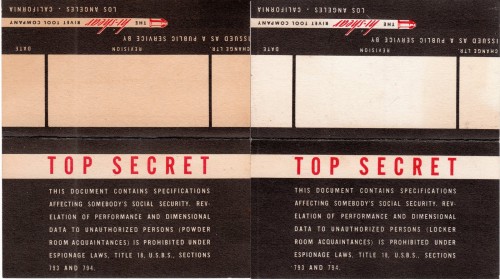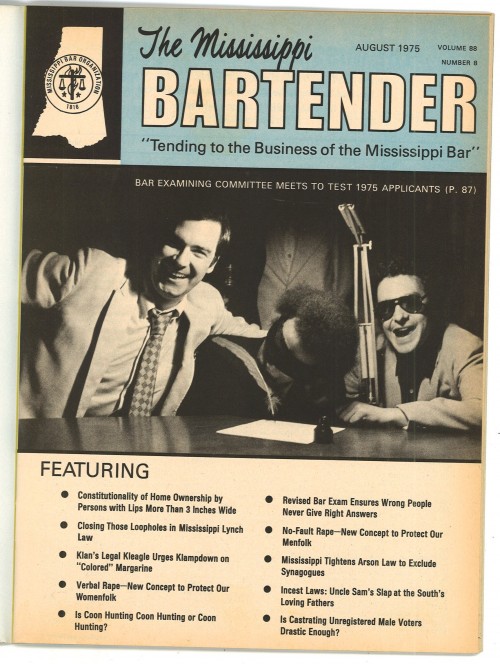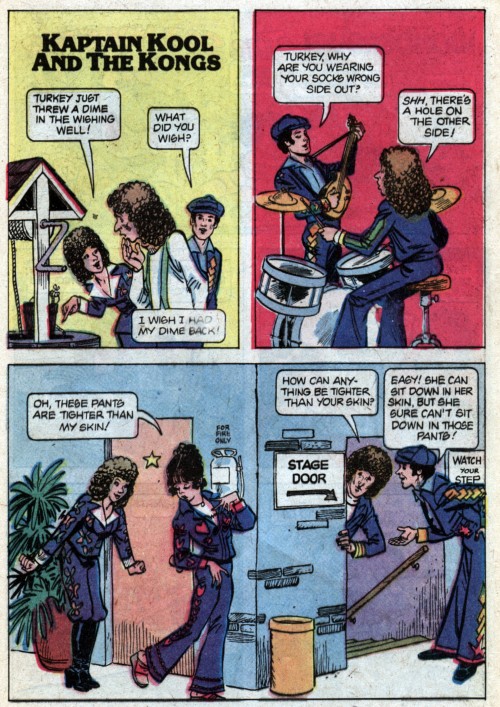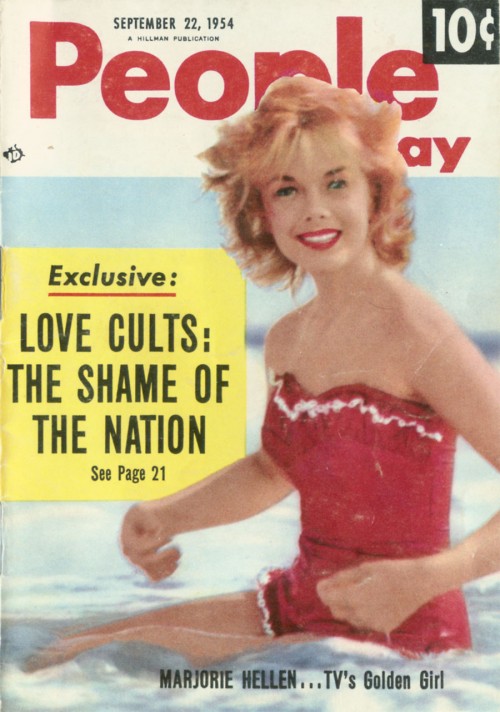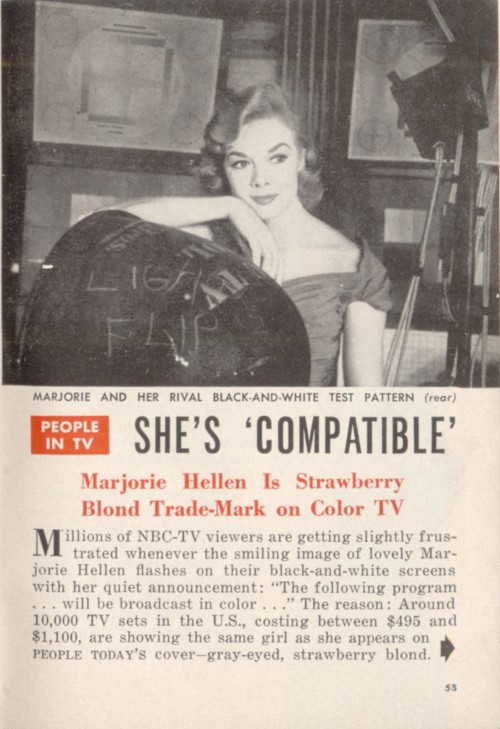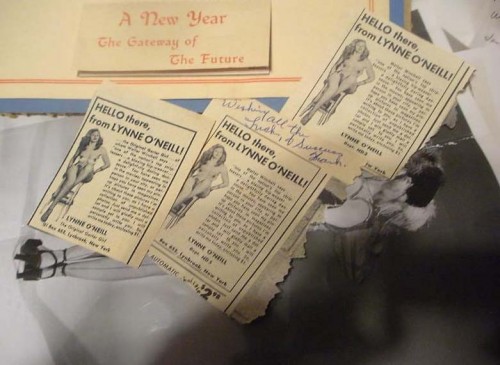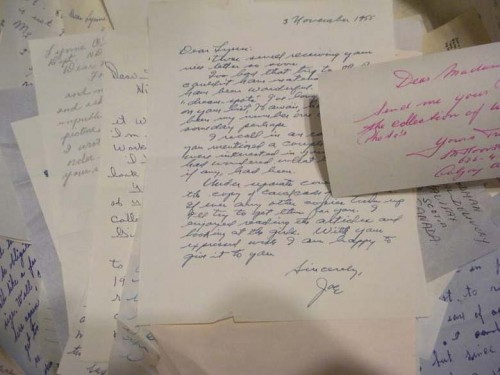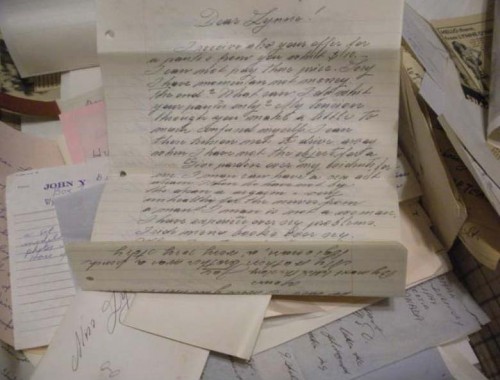
Category: Sexism Is Sexy
Pinup pandering & sexist stuff.
Suffering A Man In A Dress For Suffrage
On the front of this 5 3/4 X 3 1/2 “snapshot,” which the seller says is circa 1915, someone has printed “AN ARIZONA SUFFRAGETTE.”
As I cannot handle this photograph, I am not certain of it’s age — but I am certain that the “suffragette” it is a man wearing a dress and apron. Something about the photo feels more modern than 1915… Maybe it’s just that men putting on dresses to mock women for being too masculine to be pretty, that equal rights for women is as silly as a man wearing a dress, that the whole thing is just too-too familiar.
How To Dress For Success: Suffragette Edition
In The Washington Post, November 1, 1909, an unidentified “London fashion designer” gets bitchy and judgmental about how suffragettes dress. Yes, even though I don’t know if this possibly fictitious designer is male or female, I say “bitchy.” For even should ye olde fashion designer be both real and male (gay stereotypes aside), the fact that this item appeared at all in the Society pages, is proof of the bitch factor.
But perhaps most importantly are the number of appearances of myths, stereotypes, and general mean spiritedness which are preyed and played upon today:
The worst blow the cause of equal suffrage has received is the charge that its champions are careless in dress. Women who are not neat in attire and care nothing for personal adornment cannot hope to attract or influence men, and the future is gloomy for the British suffragettes at least. A London fashion designer has divided the suffragettes into four classes, each one marked by distinctiveness in dress.
“In the first is the woman of independent means,” says this fashion critic, “who can can and following her habit does dress well, and also the woman of limited income with an instinct for clothes Secondly, there is the working suffragette, who, as a rule, is a typewriter, and goes to the office in neat shirt waist and skirt She does not differ in any way from the woman clerk in any ordinary office, or the school teacher and secretary Thirdly we arrive at the thin, corsetless esthetic type, the modern development of the love-sick maiden who adorned Bunthorne These ‘willowy’ suffragettes adopt the empire and pinafore gown, with strange embroideries and sometimes strange results Last of all comes the suffragette who looks as though she had just returned from the wars and was still in fighting kit She generally wears a green costume of skimp design and rough material, a purple scarf, an impossible complexion, ‘something’ on her head and ‘something’ on her feet Few suffragettes have the faintest idea how to dress their hair Either they have not the time to spare from work for the great cause to give their hair ordinary care or attention, or else the languid drooping style and the straying wisps of hair are meant to illustrate the down-trodden station of women”
All of which should make the most ardent suffragette pause!
Do Women Have To Be Naked To Get Into U.S. Art Museums?
Made by the Guerrilla Girls; found at Experimentations Of A Teenage Feminist.
Vintage Gold Diggers, 1952
I’m sure this pair of vintage advertising pieces from/for the Hi-Shear Rivet Tool Company were intended to be humorous, in that oh-so-popular risque way of 1952; but I find them predictably insulting. It’s not that they’re nude — I collect vintage nudes and risque materials. Or even that “he” is allowed modesty while “she” wears the gloves and smile of a burlesque performer. (Frankly, as nearly every woman has noted in the Anthony Weiner affair, the less male genitalia seen the better.) But it’s what else is seen inside these “Top Secret” cards when they are open…
He has a number of dependents — dependents, not children; she has none.
He has a payday; she has none.
He has a car; she has none.
He has a hobby; she has a pastime — with places to check “yes” or “no”?!
*sigh*
Maybe women wouldn’t be seen as gold diggers if they had the opportunity to earn their own paychecks, own their own cars, not be seen as dependent children… Have a legitimate hobby even.
Both vintage pieces from the collection of Jim Linderman.
Mocking Marketing To Women
An awesome video from BBC’s Look Around You on The Petticoat 5: The first computer designed just for women. “The computer was created by Patricia (her surname is silent).”
Watch and be amazed.
http://www.youtube.com/watch?v=0GThtMAZGYU
While clearly satire, I love how this precisely hits so many key points about products for/marketing to women.
“There’s nothing gays hate more than when people treat us like women.”
Cameron:There’s nothing gays hate more than when people treat us like women. We’re not. We don’t want to go to your baby shower. We don’t have a time of the month. We don’t love pink.
Mitchell: You love pink.
Cameron: No, pink loves me.
I had mixed emotions about this past week’s episode of Modern Family… I don’t think gay men are women or should be treated like them, but the attitude about women was practically sneering, as if, again, there’s nothing lower than being a woman.
Mississippi Paper Burning (Hot Vintage Magazine Blog!)
I’ve fallen in love with a newly discovered blog: Visual Arts Library Picture & Periodicals Collections, part of New York’s School of Visual Arts. And not just because David Pemberton, the Periodical/Reference Librarian who runs the blog, linked to my (obsessively detailed) post on The Mentor magazine, either. (Though I am a sucker for librarians and curators — and links don’t exactly hurt.) No, I’m in love with this new-to-me blog because of it’s content.
Sure, the visuals are great — as you’d expect from a visual arts school library. But it’s more than that. It’s the writing. Not just the historical context I crave, but the frank tone I adore. Such as the delightful description of National Lampoon Magazine as having “heaping sides of boob and toilet humor.” (I know I’m a fan of heaping boobs and even side-boob *wink* I’ve even succumb to toilet humor plenty of times.)
But the best part is the mix of selected offerings. Again using the National Lampoon post, look at this gem from the August 1975 issue:
Many of the magazines have embedded publications in them that parody other actual publications, such as this one that is supposed to have been put out by the state of Mississippi Bar Association featuring articles on “Closing Those Loopholes in Mississippi Lynch Law” and “No-Fault Rape–New Concepts to Protect Our Menfolk:”
I’m absolutely dying to read that! I bet most of the satirical messages are still relevant today. But then I love to read what I collect. …How else can I obsessively research it, over-analyze it, blog about it?
Confessions Of Culture Shifts & Gender Bias
Sometimes being 46 years old — and a woman — is an amazing thing. I’m often fascinated by the cultural shifts I’ve witnessed; too often dismayed by the cultural shifts promised which have not occurred, been set further back even… But it sure has been a shifty four decades.
I often wonder if other individual women in other generations have anything to compare…
I’ve thought my Great Aunt M had lived through some amazing changes — suffrage, working during WWII and returning back home when the men came back to claim “their” jobs, the choice not to have children in the atomic family age… Amazing cultural shifts in one lifetime.
I’ve long been aware of my mother’s experience — but usually from the point of view of what it’s been like to have been her daughter. She was the first and only mom I knew who consistently worked outside of the home. At first it may have just been for the money; waitressing and the like. But by the late 70’s she was progressing from “just an office job” to reading The Assertive Woman, attending workshops on how-to-dress-for-success, and actively pursuing a career. As the only kids in the neighborhood — and in our family — with a wanting-to-work mom (and a father who supported her choice and her work), my sister and I had a different perspective of women’s lib: equal parts of liberation, greater responsibilities, and increased expectations. …This could be a long post by itself.
But just a few days ago I had an astonishing talk with my mother which made me reexamine just what it must have been like for her…
 She and I had been discussing how different my sister and I are (I’ve always said that if we hadn’t been born sisters, we never would have met), and I said, “I could understand it better if she and I had been born further apart, but there’s only a year and a half separating us — we were raised by the same parents, at the same time in their lives.”
She and I had been discussing how different my sister and I are (I’ve always said that if we hadn’t been born sisters, we never would have met), and I said, “I could understand it better if she and I had been born further apart, but there’s only a year and a half separating us — we were raised by the same parents, at the same time in their lives.”
And then that’s when my mom shared some stories that rocked my brain.
When my mom was in high school, this would be the late 1950s, she wanted a summer job. Her father said he would recommend her to the diaper washing service next to his auto-body shop if she promised to work every single day — not miss one day, or ever be late. She agreed, he made the recommendation, and she got the summer job.
She went in to work every day, all summer long. Then one night, she and her boyfriend — her first love, broke up. She spent all night crying, as teenage girls will do. When she woke up and her father spotted her in the hall, he asked her why she wasn’t yet dressed for work. She responded that she was a mess, that she could barely see through her puffy eyes, that she wouldn’t be going into work that day. Her father looked directly at her, said, “You gave your word,” then turned on his heel and left.
Mom quickly got dressed and to work on time. She never missed one day of work and lived up to her word.
When it came time for her younger sister Vickie, mom’s junior by nine years, to get a summer job, Vickie only worked four days before she quit. Years later, when having some sister-chat, my Aunt Vicki asked her sister, my mother, “Why didn’t they teach me to be responsible, like they did you?”
My mom’s response was, “You came along at a different time in their lives; you were their baby and they had different expectations of you.”
That is probably a fair analysis. And an amazingly insightful, non-spiteful, response from my mother to boot.
But my mom wasn’t done sharing her stories.
A few years after the summer laundry job, my mom worked full-time as a secretary at a finance company. This was at the same time that her brother, Mike, just two years her junior, was working at Pabst. My mom was paying $15 a week in rent to her parents. She thought nothing of it until she discovered that her brother wasn’t paying anything to their parents.
When she asked her parents why she paid rent and her brother did not, the answer (given in that “you’re so silly to ask” tone of condescension) was that “she was working for pin money, but Mike was a man.”
Even though “Mike the man” wasn’t supporting a family (his paycheck went to purchase beer), the assumption was that he was working for a future, that his paycheck and job were more important. He was expected to work; she was not. The price for her frivolity in dabbling in employment was one she would have to pay for.
Even now when I think about this I am amazed. Not just that this greatly shifts my perception of my beloved grandparents, who were a product of their own times, but that my mother who was raised by and living with these people had the guts to question her parents about this gender bias.
But that’s not even the worst of it.
When I expressed my surprise and shock — including that I’d never heard these stories before, my mother shared one more…
This one is about my cousins, Lisa & Danny, who are my Uncle Mike’s kids.
Recently, my cousin Lisa was out to lunch with my mom and she confessed that both she and her brother felt they never pleased their father; Danny for not being a macho sports guy — and Lisa for not being a boy at all. It was so bad that Lisa said, “You know, my mom never read to me. Not once. She read to Danny.” And then she rapidly tacked on — as if risking being accused of being unfair or mean-spirited, “I could listen though.”
Images of a small shy child silently lurking in the doorway while a mother snuggled with a sibling on a bed, reading to him from a book he’d selected… *shudder*
I always wondered why my cousin Lisa was so shy — painfully so. Ill-confident, uncomfortable in her own skin. How can you be anything else when your own parents don’t think you’re worthy of being read to because you’re not a male child?
It sounds the stuff of the 1950s, not the 1960s and 70s… If “America” at all.
But here it is, gender bias bullshit, from real lives, not text book depictions; from my family, some of it even in my lifetime. It’s real. It’s still living here, if only in echos. And poor self esteem.
Image via Steady Mom.
Barbiturates Like Candy
I’ve been listing a lot on eBay, so be prepared for observations and odd thoughts on what I find — like this gem: a vintage medical advertising blotter for triple-barbiturate capsules by Wyeth called Ethobral.
“for all patients who cannot sleep…”
“nearest to the ideal hypnotic…”
What strikes me most about this promotional piece is the sexist ageism. First, note that illustration: A little old lady, complete with her hair in the “granny bun,” has what appears to be a box of open chocolates on her lap — and still she weeps.
Above that, in extra-fine print, “Sleep for the menopausal patient.”
We’ve all heard about the misogyny in medicine; we’ve all heard about the medicating of women for all sorts of “mysterious ailments” that men just don’t suffer from. And we all know about the giving away of barbiturates to women as if they were candy. But seeing this, seeing a “menopausal patient” — which can only be female — depicted as a crying grandmother trying to self-medicate, ineffectively and stupidly, with chocolate, as the only image on this advertising piece for medication “for all patients who cannot sleep” drives the point home like a railroad spike. To the chest.
Is The Money Where Your Mouth Is? Phone Sex As A Career
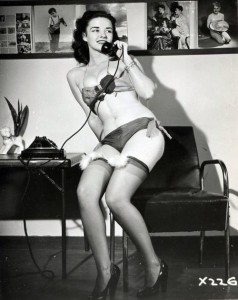 Making a full-time living off being a phone sex operator (PSO) seems the stuff of urban legend these days. Being paid to deliver sex fantasies over the telephone in the digital age of the Internet seems even to make claims of supplemental income from the career dubious at best. But according to the 10 women I interviewed, there’s still money to be made in talking dirty over the phone!
Making a full-time living off being a phone sex operator (PSO) seems the stuff of urban legend these days. Being paid to deliver sex fantasies over the telephone in the digital age of the Internet seems even to make claims of supplemental income from the career dubious at best. But according to the 10 women I interviewed, there’s still money to be made in talking dirty over the phone!
While the general consensus seems to be that the real money is made by independent phone sex operators, all 10 of the phone sex pros stated that working for a phone sex company or in some other facet of the adult industry is the best way to get the lay of the land, so to speak, and begin your new career.
If you are comfortable talking with strangers about intimate matters, how do you begin? With some research online, of course. Many phone sex companies place ads and have their own websites with online applications. When you find a lead on a job, treat it as you would any career opportunity and ask questions.
Probably the first thing you want to be clear about is whether or not this is a work from home job opportunity or if you’d be working on location. Not only is working on location less common of an option, it’s typically paid for at a lower rate, and, according to the professionals I spoke to, a lower quality phone sex service, with all that implies.
Also be sure to ask about the required number of hours or shifts you’ll be required to work; even working from home, phone sex companies require you to commit to scheduled hours just as any other employer does.
Along with asking questions and reading and the phone company’s website, you should investigate the company. Google the company name, number, etc., searching for reviews and commentary from PSOs and clients alike. Evaluate what you read in terms of the company’s stability and reliability in terms of pay. And don’t forget to ask about the details.
Phone sex, like any industry, has it’s own terminology and duties which seems like mumbo jumbo to those of us who are neither phone sex workers or callers. Some companies require PSOs to perform dispatch duties, whereby they take shifts answering the main telephone number, taking caller billing information and matching them with the most suitable PSO available who can meet their erotic needs. Typically, those dispatching shifts are paid at an hourly rate. Other companies expect their phone sex actresses to also spend time “trolling” or looking for new clients online, buying advertising, and performing other marketing and promotional duties. Traditionally, PSOs who perform trolling are paid more per minute than those who do not, and sometimes they are reimbursed or otherwise compensated for their efforts as well. It is highly recommended that you ask about these duties and any other duties you’d be expected to perform in addition to your performances with callers.
When you work for a phone sex company, you’ll receive some training and support; all the technical stuff as far as phone numbers, connections, billing, your character ID and photos, etc. will be taken care of; and there will be some base of established clients too. But when you work as an independent, all of this falls to you.
Even if you opt to use a phone sex service platform such as NiteFlirt, MyPhoneSite, or TalkSugar, and therefore have the technical issues and billing rather handled for you, there’s a lot of work to be done before you ever get your first call.
All of the PSOs I spoke with were independents, roughly half using those aforementioned phone sex service platforms, and yet all listed marketing or promotions as the one aspect of their business that took up most of their time, even after years in the phone sex industry. Even using the phone sex platforms, which have established customer bases and website traffic, there’s great competition among the PSOs to stand out and get the calls.
This is due in no small part to the low barrier of entry to the phone sex business. All one needs to do is provide valid proof they are of legal age to work in the adult industry, and, generally with the same documents that prove age, provide “Right to Work” documents in the U.S. Which means that nearly any adult female can start her own phone sex business — and nearly any adult female can fail at her own phone sex business.
In order to stand out, get calls, and cultivate your own established customer base, PSOs need to market themselves — on and off any phone sex company or service platform website. All the PSOs I spoke with stated that in addition to managing their own profile pages, placing ads, using forums and social networking sites, and the like, they spent most of their time while waiting for calls running their own websites and blogs. Which means they each developed at least a rudimentary knowledge of blogging, SEO, and other web development issues.
The trade-off for this extra work means the independent PSO has greater control over the calls taken, the rates charged, and the hours worked.
As for the amount of money you can expect to be paid as a phone sex operator, it varies. Some PSOs working for companies are excited to get $1 a minute they are on the phone; which could quite literally mean being paid $15 for 15 minutes of work — but this is all they have to show for having hung around, waiting for calls, for a six hour shift. Other independent PSOs claim to make more than $1,500 a week working less than 20 hours — but this after months or years of paying their dues building a client base and regular callers.
In short, there is no short route to quick riches with phone sex. But if you start, working to gain the experience and skills, building a supplemental business, who knows where you could go?
For more information on making a living as a phone sex operator, check out the Phone Sex Secrets blog.
Trophies For Misogynists
Vintage ad for wall-mounted female human heads reads:
“Stuffed” Girl’s Heads! Only $2.98
Blondes, redheads and brunettes for every man to boast of his conquests…the first realistic likeness of the exciting women who play an important part in every man’s life…and one of the nicest qualities is that they don’t talk back! Accurately modelled to three-quarters life size of real galls and molded of skin-textured pliable plastic, these heads are so life-like they almost breathe. Saucy glittering eyes, full sensuous mouth and liquid satin complexion, combined with radiant hair colors give astonishing realism to these rare and unique Trophies. Blonds, redhead or brunette mounted on a genuine mahogany plaque is complete and ready to hand on the wall for excitement and conversation.
Not a lot leaves me speechless. But here I am.
Found at The Immaculate Consumption.
Kaptain Kool & The Kongs On Gender & Fashion
From issue number two of The New Krofft Supershow comic (1978), deep insights into gender and fashion…
In panel two:
Turkey, why are you wearing your socks wrong side out?
Shh, there’s a hole on the other side!
‘Cuz men are stupid; they never change or replenish their socks — or underwear.
(Confession: I sit here right now, my bare toe sticking out of — wait for it! — my husband’s sock. Why? I am in need of purchasing more socks for myself. …However, it is so fun to say, “My toe is sticking out of hubby’s sock.” That’s how close we are!)
In panel three:
Oh, these pants are tighter than my skin!
How can anything be tighter than your skin?
Easy! She can sit down in her skin, but she sure can’t sit down in those pants.
‘Cuz women are stupid; they kill themselves for fashion.
(Confession: I wore tight Jordache jeans. They were tight… But obviously if I wore them to school or took a ride in a car, I could sit in them. …And I do recall that men’s jeans were just as tight. In fact, I vaguely recall it being some sort of a competition.)
PS Bonus points for the ironic “Watch Your Step” sign in the background of that last panel.
Open With A Dumb Blond Joke
Seems Juliet Lowell is off to a rockin’ start with this joke book “for adults only” — the cover features a dumb blonde joke (cover image) and a sexist poke (“for adults and adultresses”).
Help For The Gold Diggers Of Victorian Times
A rundown of Victorian Atchison’s most eligible bachelors, as published in The Atchison Globe, January 6, 1885. Via Ye Olde News, a Tumblr site that actually does document where stuff comes from. (Yes, I Tumbl(r) from time-to-time.)
Ah, I love tracking old romance in newspapers — a la the Von Dewitz twits.
“To My Valentine I’ve got a Mortgage on you, too!”
Ah, yes, another reminder that women belong to men; we are so much their property, that you can woo them with that fact on a Valentine. (Vintage Valentine via kimmly.
Because Men Are Already Talking To Your Chest
How about this vintage novelty telephone sweater from the 50’s? Via terrasita.
What Will The Girl Become?
Via WFMU.
Ranch Romances & Adventures
Ranch Romances & Adventures, May, 1971.

Contrary to what Jack Martin/Gary Dobbs says, I do not see Ranch Romance (& Adventures) magazines as primarily for women.
Jack/Gary says they must be “aimed at young women since all of the stories have a romantic element to them.” But come on now, dude, I know this may be difficult for a man who loves Westerns to admit but the whole genre – from books to films — is nothing but male romance novels and dick flicks. Sure, there’s some action in there; but the guns and body counts are there to win the damsel, the dame — the 500 miles he would walk just to fall down at her door.
Stop living in denial.
You men are just as much suckers for romance as we women are. You want to read about a good chaste kiss, a ravishing bodice ripping — and this publication proves it.
Or does it… Perhaps I am biased more than a bit by my feminine experiences and feminist equality-seeking nature. For over at Laurie’s Wild West, Laurie Powers shares the story behind the pulp magazine, using the publication founder’s own words. Harold Hersey claimed full credit for launching Ranch Romances in September 1924 (The “Adventures” joined the “Ranch Romances” in 1969) in his biography, Pulpwood Editor. Hersey writes:
My home run was Ranch Romances. I conceived of the idea of combining the Western and the love themes in a single magazine under the title of Western Love Stories. Our distributors considered it too close an imitation of the Street & Smith titles. We were told to think up another. The result was Ranch Romances and it was an almost instantaneous hit with women readers. Instead of the cowboy hero, we offered the cowgirl heroine. Bina Flynn, the editor we chose to handle the fresh idea, built the magazine into a huge success.
While I think combining Westerns and Romances is redundant, either I’m wrong — or Hersey’s another one of these men afraid to admit the romantic truth about men. Maybe, just maybe, the truth of Ranch Romances‘ success lies in the complicated truth of this simple line: “Instead of the cowboy hero, we offered the cowgirl heroine.”

Women likely responded to dreaming the possible dream of a strong female heroine who was still desired by men. Men likely felt reciprocally reassured that even today’s ballsy woman still could be wooed and won by a macho male. (However, as always, the stories end before the truly difficult part of meshing roles and living happily ever after begins; like dirty dishes in the sink, no one wants to get to that part.)
Laurie Powers touches on some of this modernized gender stuff in her post too, so read that as Exhibit A. And as further proof of the male adoption of this publication I’ll let you know that the previous owner of my May 1971 issue was male. And check out the sexist ad on the back cover.
Anyway, this Ranch Romances & Adventures I have makes me sad. (It probably made others sad too as it was the publication’s last year.)
Ranch Romances may have been more of a pulp publication, prior to the mid-1960s at least, with fantastic graphics and fantasy fiction, but by this point the magazine was more personals ads digest than pulpy delight.
Of course, I may be biased. Again. I prefer the vintage styles more than the retro ones, and my “like” barometer is built upon that grading system. But from what I’ve seen and read, Rance Romances & Adventures is a desperate combination of personal pleas and ads designed to make money off those in despair.
(I’ll be sharing more of scans from this particular issue here and over at Kitschy Kitschy Coo as Valentine’s Day approaches.)
Sign Of The Times
No actual date listed for this anti-suffrage postcard.
This post was brought to you by best online casino bonus.
Old Corny Aggie Jokes
I’ll admit I knew nothing about this retro joke book when I snagged it at an antique shop; all I needed to pick it up was a stork on the front, and the $1 price penciled inside allowed me to bring it home.
(Son Of A Son Of… 101 Aggie Jokes, Vol. 3, copyright 1969, Gigem Press (my copy is a First Printing, September, 1969) was created to be a postal piece.)
The front cover birth control gag goes like this:
Do you know what Aggies do with birth control pills?
They feed them to storks.
And that should be enough to satisfy a dollar purchase — but I’m obsessive, remember?
First I had to learn what an “Aggie” was or is: students (current and former) at Texas A&M University are called Aggies after the school’s agricultural roots. Then Barry Popik had to educate me on what turns out to be a rather fascinating bit of history about these very books:
Aggie jokes became legendary because of two events in 1963 and 1965. In 1963, Texas A&M started to admit women. The University of Texas (already co-ed) and others saw humor in this situation. In 1965, the book 101 Aggie Jokes was published. The book would go through several reprintings and new editions.
And so it seems this little joke book was destined to find its way into my feminism collection. Even if the book isn’t all about gender or the sexes, it fits the bill; here’s Exhibit B:
Did you hear about the Aggie who thought a sanitary belt was the first drink out of the bottle?
Ba-dum-dum!
I’ll couch my estimation of this kitschy book’s value with the publishers sentiments on the title page:
This collection of jokes has been assembled from general public sources. It is not the intention of the publishers to ridicule or degrade any institution or individual. The purpose is to chronicle an important chapter in American humor.
To cover my own ass, I’ll also include “gender” along with institutions and individuals. *wink*
FYI, the publishers name is based on another Aggie reference, the Gig ’em greeting.
Marjorie Hellen: “Identification Girl” The Ultimate Objectification Or Not?
Featured on the cover of People Today, September 22, 1954, was “Marjorie Hellen… TV’s Golden Girl.”
Her story begins on page 55, filed under “People In TV,” Hellen’s story is titled She’s ‘Compatible’ Marjorie Hellen Is Strawberry Blond Trade-Mark on Color TV.
If that’s not intriguing enough, check out the caption under the photo: “Marjorie And Her Rival Black-And-White Test Pattern (rear)”.
From the article:
Millions of NBC-TV viewers are getting slightly frustrated whenever the smiling image of lovely Marjorie Hellen flashes on their black-and-white screens with her quiet announcement: “The following program…will be broadcast in color …” The reason: Around 10,000 TV sets in the U.S., costing between $495 and $1,100, are showing the same girl as she appears on PEOPLE TODAY’S cover–gray-eyed, strawberry blond.
Marjorie, who doubles as a live test pattern for sensitive color cameras, is the “identification girl” for NBC Color TV, which has scheduled 39 90-minute “spectaculars” for its compatible system (the shows can also be received in black-and-white) during 1954-1955.
The article credits “an attack of anemia” for Hellen getting the gig — not specifically for her coloring (though only her doctor knows for sure), but for her availability:
It kept her from going to school, made her available when Claude Traverse, manager of NBC’s color unit, selected her from photos as having the “ideal flesh tone” for lining up color cameras.
Hellen may be more familiar to you as Leslie Parrish; she changed her name in 1959.
It’s Like A Pucci In The Face
 If you have difficulty being a woman and knowing what you want, you can blame it on Emilio Pucci‘s death.
If you have difficulty being a woman and knowing what you want, you can blame it on Emilio Pucci‘s death.
In this vintage lingerie ad for Pucci‘s Fiore Festa line for Formfit Rogers the text boasts, “How does he know what women want before they know themselves?”
Because women are such fickle stupid creatures, we don’t even know what we want to wear.
Even if all we do is shop.
Right?
It’s true; I have conflicting responses to vintage lingerie advertising. But who doesn’t?
(And if you don’t, then we should talk!)
Image via devocanada.
Because There’s Nothing More Shameful For A Boy Than Looking Like A Girl
One of the “367 prize winning household hints” Hint Hunt booklet (the better ones will be found at my vintage home ec site, Things Your Grandmother Knew), this tip “for mothers only” advises that “to cure boys of the habit of not keeping shirttails tucked in, sew an edging of lace around the bottom of the lad’s shirt.”
The Original Garter Girl’s Estate Shows Something More Shocking Than Lingerie
 When I spotted this post at Slip of a Girl’s lingerie blog, I thought I had remembered something about the former burlesque star, “The Original Garter Girl,” Lynne O’Neill…
When I spotted this post at Slip of a Girl’s lingerie blog, I thought I had remembered something about the former burlesque star, “The Original Garter Girl,” Lynne O’Neill…
Sadly, it was that she’d passed away recently; her estate sale was held October 9, 2010, in Hempstead.
Along with the dearth of personal items from O’Neill’s estate, a lot of memorabilia is up for sale at eBay — but none more fascinating to me than this collection of several thousand of letters
listed by Jeff’s Paintings Books Music Stuff
.
The seller’s description is as follows (yes, they wrote in all caps, etc.):
UP FOR AUCTION IS AN ARCHIVE, CONSISTING OF SEVERAL HUNDRED PIECES OF CORRESPONDENCE FROM MEN – ALL FROM THE MID 1950’S – RESPONDING TO PERSONAL ADS THAT LYNNE O’NEILL PLACED IN NEWSPAPERS. THE MEN ENCLOSED AS LITTLE AS A DOLLAR FOR PHOTOS OF LYNNE O’NEILL, HOWEVER, SOME PAID SIGNIFICANTLY MORE FOR UNDERWEAR (NOW AVAILABLE ON EBAY FROM OTHER SELLERS), GARTERS, MOVIES, AND RISKE MATERIAL.
MANY OF THE LETTERS ARE DETAILED AND LENGTHY. SEVERAL RUN SIX PAGES OF LONGER. A FEW LETTERS ENCLOSED PHOTOS. ONE GUY THOUGHT HE WOULD IMPRESS LYNNE WITH A PHOTO OF HIS GAS STATION. OTHERS DISCUSSED THEIR MEETING LYNNE, AND THEIR RECEIPT OF A LETTER FROM LYNNE. ANOTHER DREW PICTURES OF LYNNE/ IT REALLY IS AN AMAZING ARCHIVE, OF AMERICAN LIFE IN THE 1950’S. MEN ASKING FOR HARD CORE PHOTOS IN VEILED TERMS “YOU KNOW WHAT I LIKE” AND SEND ME PHOTOS OF YOUR “BUTTERFLY”. (I DIDN’T EVEN KNOW WOMEN HAD BUTTERFLIES). THERE ARE LETTERS FROM DOCTORS, PHARMACISTS, SERVICE MEN. EVERYONE CLAIMED TO HAVE A COLLECTION OF “ART PHOTOS”. IT REALLY WAS AN ASTOUNDING VIEW OF LIFE IN THE 1950’S AND HOW THEY DEALT WITH SEX AND PORNOGRAPHY. ALSO INCLUDED ARE CUTOUTS THAT LYNNE PLACED, AND A FEW PHOTOS (NOT IN GREAT SHAPE) THAT WERE IN THE BOX.
I AM ALSO ENCLOSING A 1956 CALENDAR OF LYNNE O’NEILL
Dear Santa, if I could have but one wish this year…
It’s unlikely that I shall receive a windfall to equal the sum requested ($399.95 or “best offer) — or that if I should, that my husband would let me “invest” the tidy sum in such ephemera (though if you cared to give me the funds, or purchase the collection for me, it could be our little secret!), but I certainly covet it.
The idea of reading such intimate letters based on risque celebrity — from the Every Man to The Ultimate Woman — is so delicious I dare not ponder it any longer lest I click and buy it and end up with no way to pay rent.
*heavy sigh*
But aside from whining about my lack of discretionary income, aside even from waxing on about the insightful poetry of male psyche left in such an archive, I mention this for other reasons.
As a collector and a dealer (for yes, I deal in and sell collectibles as well as hunt, buy, research and write about them), I find something else fascinating about this auction listing; from the first part of the listing:
OVER THE NEXT SEVERAL WEEKS, YOU WILL SEE A LOT OF LYNNE O’NEILL ITEMS ON EBAY. SHE RECENTLY PASSED AWAY, AND HER ESTATE WAS LIQUIDATED. MANY OF THE ITEMS OFFERED WERE AVAILABLE IN LARGE QUANTITIES, AND TO THE ESTATES CREDIT THEY REFUSED TO JUST GIVE IT AWAY. THEY HIRED INDIVIDUALS THAT UNDERSTOOD THE HISTORICAL VALUE OF ITEMS IN THE HOUSE, SO ITS UNLIKELY YOU’LL BE ABLE TO BUY IT SUPER CHEAP ON EBAY. THAT IS, UNLESS THE MARKET IS FLOODED, AND EBAY IS NO LONGER A VIABLE OPTION FOR THE O’NEILL MATERIAL. I DON’T EXPECT THAT TO HAPPEN THOUGH, BECAUSE WHILE THERE WAS A LOT OF ITEMS BY THE STANDARDS OF A SMALL COMMUNITY, I THINK THE NATIONWIDE DEMAND WILL FAR OUTWEIGH THE SUPPLY OF WHAT WAS AVAILABLE, AND PRICES WILL CONTINUE TO RISE.
THIS PARTICULAR ITEM, HOWEVER IS UNIQUE. NOONE ELSE HAS IT, AND NO ONE ELSE CAN OFFER IT TO YOU ON EBAY OR OFF.
Sellers of collectibles and dealers of antiques often find themselves in the place of rationalizing or even defending their actions — including pricing items for sale.
It’s a sad reality based on people’s ignorance and, yes, selfishness; they feel that dealers are somehow taking advantage of the folks they buy from and the folks they sell too. Never mind that dealers must be knowledgable enough to invest in what they buy and must wait for what they hope will be a return worthy of that investment — plus whatever other fees accrue while waiting for that sale. It’s not easy-peasy-lemon-squeezey.
Further proof of dealer defensiveness lies in the Q & A published at the auction listing:
Q: Dear Jbg and the estate, I have 41 years experience buying at and conducting estate sales in the Hempstead area.The people who ran Elaine/ Lynne sale are very nice people, with expertise in about 33% of the items they sell. These are priced correctly. The others are triple and one third of what the correct wholesaleish/ liquidation selling price should be. This puts them in the top echelon of tag sale services. Most of which are completely incompetent and clueless. Believe it or not these are the most successful ones as hordes of people will come days ahead and wait to take advantage of their stupidity. JBR Oct-12-10 A: I think they ran a great sale, with fair prices. I’ve read what I’ve written several times, and don’t think its negative. Its just my observation that people aren’t going to get things super cheap on ebay, because they were priced correctly at the sale. That’s a good thing. The tag sale people work for the estate, not for the buyers. I’m certain that they maximized the estate’s dollar. Others either would have priced to high , and not sold a thing or priced to low, and given it away. Q: That statement you made about the Estate of Lynne O ‘Neill is not completely true the Estate hired a 15 year experience antique and collectible specialist and the Estate is now meeting and will examine what transpired. So i highly suggest you Edit your statement about the estate sale Do you have a receipt for what you paid for to prove you paid alot in comparison the what you are selling your item for? Sincerely the Estate Oct-12-10 A: I think my statement is intended to mean that the Estate did not give things away, which is to the credit of the folks who ran the sale. Most folks would have sold the calendars and signs for a few bucks a piece to get rid of them, and then they’d be flooding ebay at $5 a piece. I don’t think that’s going to happen. Not sure what the panties sold for, but unless the folks running the sale failed to comprehend what they were (and that seems unlikely) they weren’t a dollar item. Sincerely, the customer.
I find it rather unprofessional that the eBay seller would feel the need to explain how the collectibles market works; even if under the guise of education (the interested collector will be more interested in provenance and price than an economics lesson), and odder still that the estate company would misread the auction listing so badly (of course, perhaps we’re reading an edited version?). But the fact remains, dealer are so harassed and worried about their reputations, they are willing to air more dirty laundry than the panties worn by a former pinup queen.
I just wish there was a way to use all of this to my advantage; rather anything to end up with this collection of vintage burlesque ephemera.
Sign Of The Times: 1976 (Labor Day Edition)
Which serves as a good reminder for this Labor Day… Playboy Bunnies, models, phone sex operators, and sex workers work hard too. That’s not a joke; we have to treat others with equality and respect as well as demand it.

Images via Swimsuit Issue and Suicide Blonde.
“Yeah, I’m still going!! They forgot to cut my tongue out!”
There’s truth in comics, you know. Just look at this statement on the power of women’s voices:
The brunette is Pat Patriot, “America’s Joan of Arc,” and the blonde is Heppy, her sidekick, I guess. This is how they appeared in Charles Biro and Bob Wood’s Daredevil #11, June 1942. Lovingly scanned & presented at Pappy’s Golden Age Comics, where, just in case you think I picked the most misogynistic or salacious part, Pappy notes the following:
Pat has a villain worthy of his name, The Mallet. He’s a torturer, and we get some juicy panels with some bondage and torture.
As is oft the case with comics, sex and sexism are in there as a mix of thrill and the ultimate threat. (And, as this is wartime, so is the racism.) But what’s really interesting is the fact that even if the setreotype of the jabber-mouth woman is there, this vintage comic does present the truth: No matter what you go through, if you’ve got your ability to communicate, your truth is your power.
Heppy! We women with voices are all right indeed.
PS As a feminist, I heartily support your right to consensual bondage and torture scenes. I just felt that needed to be said.
For Those Who Think Pin-Ups Are Stuck-Up, I Guess…
A vintage ceramic pinup — pencil holder?! While I struggle with the idea of such a pencil holder, what else could it be?

The seller, luxebetty,shares the following details:
Made in Japan 5 1/2″ tall by 5″ wide and 2″ deep. …holds 6-10 pens, markers or pencils.
So you know luxebetty’s stuck stuff in this pinup’s butt.

While I have no idea to see figurine rape, I kinda want to see the pencils sticking out… Just to see if that’s really the intended purpose.
I struggle with stuff like this; I really do.
Signs Of The Times: 1890s
An incredible antique cabinet card (from bondman2 @ eBay
) showing a home decorated for newlyweds.
Note the old paper lanterns and the plethora of handmade signs — most of which resemble tombstone R.I.P. notices.
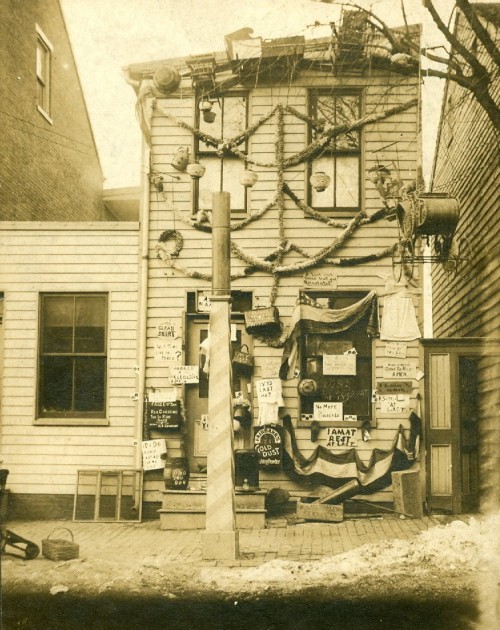

Additional seller notes:
Cabinet Card photograph circa 1890s-1900, measures 6″ x 7″, marked “This was taken when Ben Shriner was Married-Mrs. Joyce Roth, RD 6, York, Pa.”
Breaking Free Is A Drag (Or, Drag Queens Part 1)
Glowing Doll Danielle says she was “totally gob smacked” watching Freddie Mercury’s “sexy mustachioed housewife” in Queen’s I Want To Break Free.
In her post, Danielle also wrote:
I love drag queens because they can dress like women but without all of the pressure to look pretty or be sexy. I know there are plenty of women who dress like drag queens but they are few and far between and they tend to be Pop stars.
Umm, I could be wrong here, but I’m pretty sure the sole point of being a drag queen is to look pretty and be the (supposed) feminine ideal of sexy.
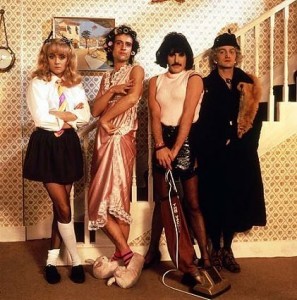 I think part of Danielle’s confusion here — and there’s plenty to be confused about traversing those fine, slinky, and slippery lines between drag queens, female impersonators, transgendered folk, cross dressers, fetishists, etc. (note: no mention of gay folk here) — is mistaking Mercury’s artistic gender-bender performance for Mercury being a drag queen.
I think part of Danielle’s confusion here — and there’s plenty to be confused about traversing those fine, slinky, and slippery lines between drag queens, female impersonators, transgendered folk, cross dressers, fetishists, etc. (note: no mention of gay folk here) — is mistaking Mercury’s artistic gender-bender performance for Mercury being a drag queen.
Freddie Mercury in drag is not Freddie Mercury, Drag Queen.
The simple & pure existence of a mustache sort of illustrates that point — and my point about a boundary pushing performance.
Danielle gets close to those distinctions when she writes the following (exactly as typed at her blog):
To me anyway, Drag culture is as much about attitude as it is about aesthetic. It seems to exude a sort of ‘Don’t give a fuck’ attitude which I think everyone could benefit from. Ultimately there is a humour born from sadness underlying the aesthetic. The theatricality used as a kind of armour against a world that is so un accepting of others.
If I could be a part of either world I just feel that I would be freer some how. I find myself, inpsite of a vast collection of clothes and accessories, dressing drably from day to day. I guess I fear judegement by small minded people and on a deeper level just want to dissapear sometimes (hard to do with electric coloured clothes, spiked accesories and gigantic hats).
The mythical non-mustached Drag Queen Mercury, like other Drag Queens, probably would have had a female name and completely distinct female persona to go with it. And none would have seen drag as an armor but as flamboyant exhibitionist expression — that people would still sling arrows at.
 Mercury in drag wasn’t exactly like Travolta in Hairspray; Mercury’s dress was a theatrical application, use of imagery to make a point. Or at least a slightly different point. And the whole point of Freddie Mercury et al and their obvious appearance as men in women’s clothing (along with other things in this video and aspects of Mercury’s life) was to expose absurdity, especially the norms of “normal,” to break free of everything — everything except that vacuum, that is. *wink*
Mercury in drag wasn’t exactly like Travolta in Hairspray; Mercury’s dress was a theatrical application, use of imagery to make a point. Or at least a slightly different point. And the whole point of Freddie Mercury et al and their obvious appearance as men in women’s clothing (along with other things in this video and aspects of Mercury’s life) was to expose absurdity, especially the norms of “normal,” to break free of everything — everything except that vacuum, that is. *wink*




